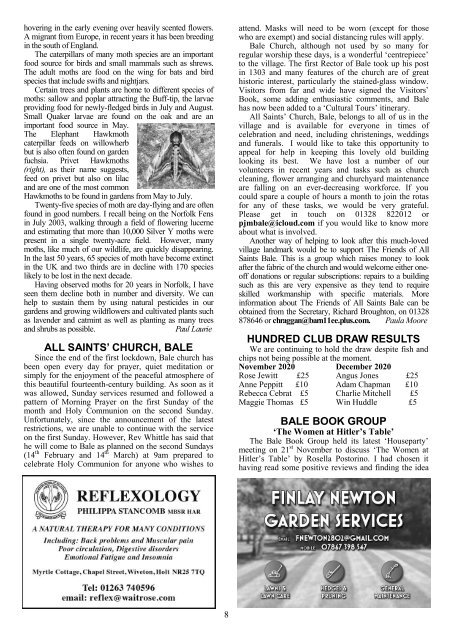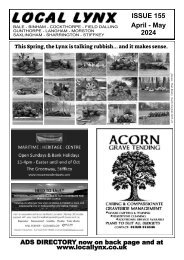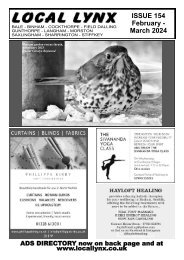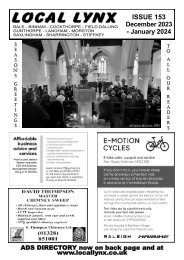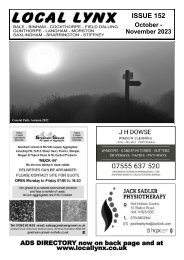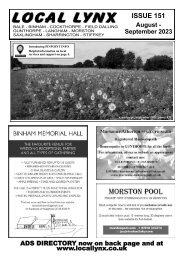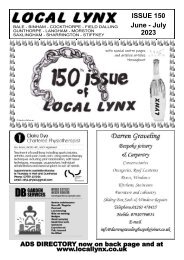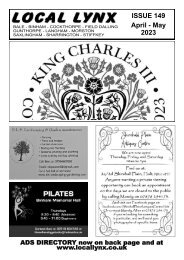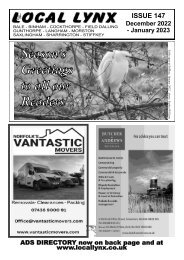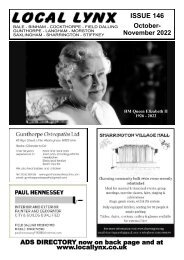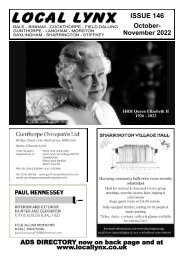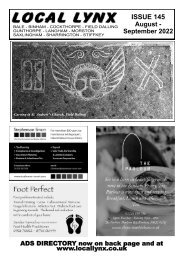Local Lynx No.136 - February/March 2021
The community newspaper for 10 North Norfolk villages.
The community newspaper for 10 North Norfolk villages.
- No tags were found...
Create successful ePaper yourself
Turn your PDF publications into a flip-book with our unique Google optimized e-Paper software.
hovering in the early evening over heavily scented flowers.<br />
A migrant from Europe, in recent years it has been breeding<br />
in the south of England.<br />
The caterpillars of many moth species are an important<br />
food source for birds and small mammals such as shrews.<br />
The adult moths are food on the wing for bats and bird<br />
species that include swifts and nightjars.<br />
Certain trees and plants are home to different species of<br />
moths: sallow and poplar attracting the Buff-tip, the larvae<br />
providing food for newly-fledged birds in July and August.<br />
Small Quaker larvae are found on the oak and are an<br />
important food source in May.<br />
The Elephant Hawkmoth<br />
caterpillar feeds on willowherb<br />
but is also often found on garden<br />
fuchsia. Privet Hawkmoths<br />
(right), as their name suggests,<br />
feed on privet but also on lilac<br />
and are one of the most common<br />
Hawkmoths to be found in gardens from May to July.<br />
Twenty-five species of moth are day-flying and are often<br />
found in good numbers. I recall being on the Norfolk Fens<br />
in July 2003, walking through a field of flowering lucerne<br />
and estimating that more than 10,000 Silver Y moths were<br />
present in a single twenty-acre field. However, many<br />
moths, like much of our wildlife, are quickly disappearing.<br />
In the last 50 years, 65 species of moth have become extinct<br />
in the UK and two thirds are in decline with 170 species<br />
likely to be lost in the next decade.<br />
Having observed moths for 20 years in Norfolk, I have<br />
seen them decline both in number and diversity. We can<br />
help to sustain them by using natural pesticides in our<br />
gardens and growing wildflowers and cultivated plants such<br />
as lavender and catmint as well as planting as many trees<br />
and shrubs as possible.<br />
Paul Laurie<br />
ALL SAINTS’ CHURCH, BALE<br />
Since the end of the first lockdown, Bale church has<br />
been open every day for prayer, quiet meditation or<br />
simply for the enjoyment of the peaceful atmosphere of<br />
this beautiful fourteenth-century building. As soon as it<br />
was allowed, Sunday services resumed and followed a<br />
pattern of Morning Prayer on the first Sunday of the<br />
month and Holy Communion on the second Sunday.<br />
Unfortunately, since the announcement of the latest<br />
restrictions, we are unable to continue with the service<br />
on the first Sunday. However, Rev Whittle has said that<br />
he will come to Bale as planned on the second Sundays<br />
(14 th <strong>February</strong> and 14 th <strong>March</strong>) at 9am prepared to<br />
celebrate Holy Communion for anyone who wishes to<br />
attend. Masks will need to be worn (except for those<br />
who are exempt) and social distancing rules will apply.<br />
Bale Church, although not used by so many for<br />
regular worship these days, is a wonderful ‘centrepiece’<br />
to the village. The first Rector of Bale took up his post<br />
in 1303 and many features of the church are of great<br />
historic interest, particularly the stained-glass window.<br />
Visitors from far and wide have signed the Visitors’<br />
Book, some adding enthusiastic comments, and Bale<br />
has now been added to a ‘Cultural Tours’ itinerary.<br />
All Saints’ Church, Bale, belongs to all of us in the<br />
village and is available for everyone in times of<br />
celebration and need, including christenings, weddings<br />
and funerals. I would like to take this opportunity to<br />
appeal for help in keeping this lovely old building<br />
looking its best. We have lost a number of our<br />
volunteers in recent years and tasks such as church<br />
cleaning, flower arranging and churchyard maintenance<br />
are falling on an ever-decreasing workforce. If you<br />
could spare a couple of hours a month to join the rotas<br />
for any of these tasks, we would be very grateful.<br />
Please get in touch on 01328 822012 or<br />
pjmbale@icloud.com if you would like to know more<br />
about what is involved.<br />
Another way of helping to look after this much-loved<br />
village landmark would be to support The Friends of All<br />
Saints Bale. This is a group which raises money to look<br />
after the fabric of the church and would welcome either oneoff<br />
donations or regular subscriptions: repairs to a building<br />
such as this are very expensive as they tend to require<br />
skilled workmanship with specific materials. More<br />
information about The Friends of All Saints Bale can be<br />
obtained from the Secretary, Richard Broughton, on 01328<br />
878646 or chraggan@barn11ee.plus.com. Paula Moore<br />
HUNDRED CLUB DRAW RESULTS<br />
We are continuing to hold the draw despite fish and<br />
chips not being possible at the moment.<br />
November 2020 December 2020<br />
Rose Jewitt £25 Angus Jones £25<br />
Anne Peppitt £10 Adam Chapman £10<br />
Rebecca Cebrat £5 Charlie Mitchell £5<br />
Maggie Thomas £5 Win Huddle £5<br />
BALE BOOK GROUP<br />
‘The Women at Hitler’s Table’<br />
The Bale Book Group held its latest ‘Houseparty’<br />
meeting on 21 st November to discuss ‘The Women at<br />
Hitler’s Table’ by Rosella Postorino. I had chosen it<br />
having read some positive reviews and finding the idea<br />
8


